
Ms. Pac-Man is a 1982 maze arcade video game developed by General Computer Corporation and published by Midway. It is a spin-off sequel to Pac-Man (1980) and the first entry in the series to not be made by Namco. Controlling the title character, Pac-Man's wife, the player is tasked with eating all of the pellets in an enclosed maze while avoiding four colored ghosts. Eating the larger "power pellets" lets the player eat the ghosts, who turn blue and flee.

Mappy is an arcade game by Namco, originally released in 1983 and distributed in the United States by Bally Midway. Running on the Namco's Super Pac-Man hardware modified to support horizontal scrolling, the game features a mouse protagonist and cat antagonists, similar to Hanna-Barbera's Tom and Jerry cartoon series. The name "Mappy" is likely derived from mappo (マッポ), a slightly pejorative Japanese slang term for policeman. The game has been re-released in several Namco arcade compilations. It spawned a handful of sequels and a 2013 animated web series developed by cartoonists Scott Kurtz and Kris Straub.
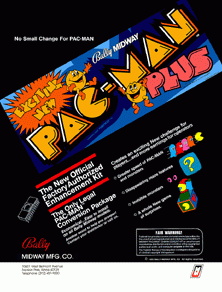
Pac-Man Plus is an arcade game that was developed by Namco and released by Bally Midway in 1982. It is part of the Pac-Man series of games.

Pac-Land is a 1984 side-scrolling arcade platform game developed and released by Namco. It was distributed in North America by Bally Midway, and in Europe by Atari Games. Controlling Pac-Man, the player must make it to the end of each stage to return a lost fairy back to its home in Fairyland. Pac-Man will need to avoid obstacles, such as falling logs and water-spewing fire hydrants, alongside his enemies, the Ghost Gang. Eating large flashing Power Pellets will cause the ghosts to turn blue, allowing Pac-Man to eat them for points.

Super Pac-Man is a 1982 maze chase arcade game developed and published by Namco. It was distributed in North America by Midway, and is Namco's take on a sequel to the original Pac-Man; Midway had previously released Ms. Pac-Man, which Namco had little involvement with. Toru Iwatani returns as designer.

Pac-Man World 2 is a video game developed and published by Namco Hometek for the Xbox, GameCube, and PlayStation 2, released in 2002. A version of the game for Microsoft Windows was released in 2004, and an isometric sidescroller was made for the Game Boy Advance in 2005. The game is a sequel to Pac-Man World (1999). The game is a platform game, where the player controls Pac-Man in a 3D platforming environment, through six worlds. In 2005, a sequel, Pac-Man World 3, was released.
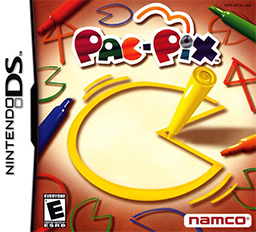
Pac-Pix (パックピクス) is a 2005 action video game in the Pac-Man series, developed and published by Namco for the Nintendo DS. As the first home Pac-Man video game to use motion controls, it involves using the Nintendo DS's touchscreen to draw Pac-Men and guiding them to eat all the ghosts on each page by using various gestures.

Pac-Attack, also known as Pac-Panic, is a 1993 falling-tile puzzle video game developed and published by Namco for the Super Nintendo Entertainment System and Sega Genesis. Versions for the Game Boy, Game Gear and Philips CD-i were also released. The player is tasked with clearing out blocks and ghosts without them stacking to the top of the playfield — blocks can be cleared by matching them in horizontal rows, while ghosts can be cleared by placing down a Pac-Man piece that can eat them. It is the first game in the Pac-Man series to be released exclusively for home platforms.
Namco Museum is a series of video game compilations developed and published by Bandai Namco Entertainment for home video game consoles. The first title in the series, Namco Museum Vol. 1, was released for the PlayStation in 1995. Entries in the series have been released for multiple platforms, including the Game Boy Advance, PlayStation 2, PlayStation Portable, Nintendo DS and Xbox 360. the latest being Namco Museum Archives Vol. 2, released in 2020.
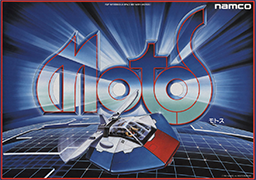
Motos is an action arcade game released by Namco in 1985. It runs on Namco Super Pac-Man hardware but with a video system like that used in Mappy, The Tower of Druaga, Grobda and Dig Dug II.

Hopping Mappy is an action arcade game developed by Game Studio and released by Namco in 1986. It is the sequel to Mappy, which was released three years prior. The game was ported to the Wii Virtual Console in Japan on June 2, 2009, followed by the Arcade Archives series for the Nintendo Switch and PlayStation 4 on January 20, 2022.
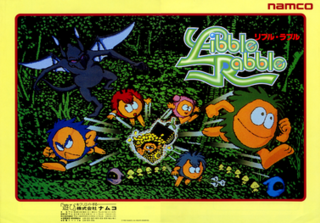
Libble Rabble is a 1983 puzzle arcade video game developed and published in Japan by Namco. The player is tasked with using two colored arrows, Libble and Rabble, to wrap them around pegs and surround small creatures known as Mushlins to "harvest" them under a time limit. The player can also uncover treasure chests that will have the player searching the stage for items in order to access a special bonus stage. It ran on the Namco Libble Rabble hardware, one of the only games to do so.

Namco Classic Collection Vol. 2 is a 1996 compilation arcade game developed and published by Namco. It is a collection of four of Namco's popular games: Pac-Man (1980), Rally-X (1980), New Rally-X (1981) and Dig Dug (1982). Alongside the original games, three new "Arrangement" games based on each game are included.
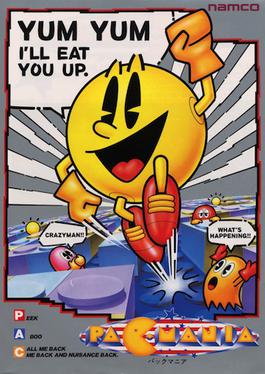
Pac-Mania is a cavalier perspective maze game that was developed and released by Namco for arcades in 1987. In the game, the player controls Pac-Man as he must eat all of the dots while avoiding the colored ghosts that chase him in the maze. Eating large flashing "Power Pellets" will allow Pac-Man to eat the ghosts for bonus points, which lasts for a short period of time. A new feature to this game allows Pac-Man to jump over the ghosts to evade capture. It is the ninth title in the Pac-Man video game series and was the last one developed for arcades up until the release of Pac-Man Arrangement in 1996. Development was directed by Pac-Man creator Toru Iwatani. It was licensed to Atari Games for release in North America.

Pac-Man Championship Edition is a 2007 maze video game developed and published by Namco Bandai Games for the Xbox 360. It has since appeared on several other platforms, including iOS, Android, and the PlayStation 3 and PlayStation Portable as a PSP mini title available on the PlayStation Store. It is an HD reimagining of the original Pac-Man arcade game; players navigate Pac-Man through an enclosed maze, eating pellets and avoiding four ghosts that pursue him. Clearing an entire side of the maze of dots will cause a fruit item to appear, and eating it will cause a new maze to appear on the opposite side.
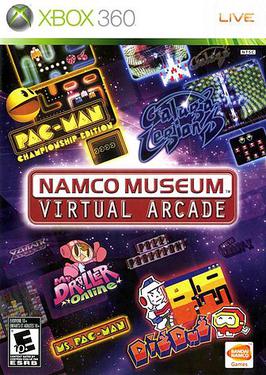
Namco Museum Virtual Arcade is a video game compilation developed and published by Namco Bandai Games for the Xbox 360. It was released in North America in 2008 and in Europe and Japan in 2009. Part of its Namco Museum series, Virtual Arcade includes 34 titles; nine of these are Namco Bandai-published Xbox Live Arcade games, and the rest are arcade games that are only accessible through the disc. Players can access the Xbox Live Arcade games through their dashboard if the disc is in the console.

Pac-Man Battle Royale is a 2010 maze battle-royale arcade game in the Pac-Man series. Developed and published by Namco Bandai Games, it was made in celebration of Pac-Man's 30th Anniversary. The game sees up to four players control multi-colored Pac-Men as they try to compete to be the last Pac-Man standing.

Pac-Man Championship Edition DX is a 2010 maze video game published by Namco Bandai Games for the Xbox 360 and PlayStation 3, later ported to Steam and iOS. It is the sequel to the 2007 game Pac-Man Championship Edition, which was the last game developed by series creator Toru Iwatani. The player controls Pac-Man as he must eat all of the dots in the maze while avoiding colored ghosts that pursue him. A bonus item will appear once the player has eaten all dots on one side of the maze, causing the layout to change. Several additions were made over the original, such as bombs that send all ghosts to the regeneration box and sleeping ghosts that will give chase when Pac-Man moves past them.

Pac-Man Championship Edition 2 is a maze arcade game developed by Bandai Namco Studios and published by Bandai Namco Entertainment. An installment in the Pac-Man series, it was released for PlayStation 4, Windows, and Xbox One on September 15, 2016; an updated version featuring an exclusive 2-player co-op mode, Pac-Man Championship Edition 2 Plus, was released for Nintendo Switch on February 22, 2018. It is a direct sequel to Pac-Man Championship Edition and the follow-up of Pac-Man Championship Edition DX+.

Aero-Cross is an unreleased platform video game that was in development for the PlayStation 3 and Xbox 360 by Namco Bandai Games. It was intended as a modernized sequel to the arcade game Metro-Cross, and the third released under the Namco Generations series of video game remakes. Players control a runner through each level in an effort to get to the end stage goal before the timer runs out. Levels feature hazards that must be overcome, and there are also power-ups that grant player with different abilities, such as a speed boost or being able to glide over the level.





















